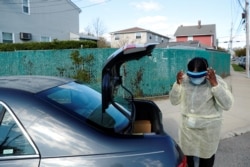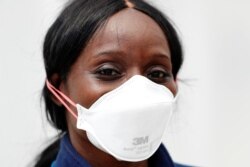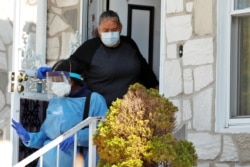Nurse Flora Ajayi parks her car on a residential block in Queens, New York and pops open the trunk, revealing plastic bins full of personal protective gear. She dons gloves, a blue gown, two masks, a face shield and shoe covers and turns to enter the home of one of her COVID-19 patients.
Ajayi, 47, works alone on the next front line of the coronavirus pandemic. She is part of a network of New York home care nurses treating hundreds of patients who have been discharged from hospitals and sent home to recover from the respiratory disease caused by the novel coronavirus.
The highly infectious disease has killed at least 20,300 people in the state, the epicenter of the coronavirus outbreak in the United States, where more people have died than any other country — at least 49,000, according to a Reuters tally.
Home care nurses have a vital role to play as patients transition from around-the-clock care in a hospital to life at home. Ajayi enters and exits virus-ridden homes daily, donning and doffing her protective equipment up to 12 times a day on curbsides around the city.
She cannot re-use the protective gear from home to home, so she keeps her car loaded with masks, gowns and gloves.
"We are also on the frontlines," Ajayi said of home care nurses, tying her gown behind her back as she prepared to enter the home of a 74-year-old woman who was recently discharged from a hospital stay with the coronavirus. "The doctors want us to be the eyes and ears."
As of April 22, 40,303 COVID-19 patients had been discharged from hospitals in New York, said the state's health department spokesman Jonah Bruno.
Clutching a bottle of hand sanitizer and with her loose blue gown flapping in the wind, Ajayi climbed the porch steps and rang the bell to a door with a bunny-shaped sign that read “Happy Easter!”
The patient’s husband, wearing a surgical mask, opened the door, greeted Ajayi with a friendly wave and stayed a couple feet back as he beckoned her inside.
It was the first time Ajayi had seen this patient since she had left the hospital. The patient’s cough was noticeably better than it had been on the phone days earlier, when Ajayi said the patient could not finish a sentence without coughing.
Ajayi conducts telehealth appointments with her discharged COVID-19 patients until they report no symptoms for three days, to reduce the risk of getting infected herself.
Still, Ajayi worries she might bring the virus back from a patient’s home to her own, where she lives with her son, 23, and her sister. She wears a mask at home and tries to stay 6 feet away from her family to limit any infection - a sacrifice she makes for the job she loves.
"I love to be part of the healing, part of the mentorship, part of the progression," she said. "It makes it all worth it."
'We don't know'
Ajayi works for Northwell Health, New York's largest healthcare provider with 23 hospitals.
Almost all hospitalized COVID-19 patients will require some medical follow-up or rehabilitation when they are discharged before they can regain their former quality of life, if that ever happens, said Dr. Maria Carney, Northwell's medical director for post-acute services.
"We’re really entering an area of 'we don’t know.' We don’t know what patients need right now, we just see that they are extremely weak, both physically and mentally," Carney said. "How can our health system deal with that next phase of recovery? It’s going to be a challenge."
Of the patients who have been discharged so far, many suffer from blood clots in their legs, muscle atrophy, aches, fatigue, cardiac issues and continued respiratory distress.
Patients who were intubated are showing these symptoms more acutely when discharged, and many also are showing cognitive impairment, which could be an effect of long-term sedation or a condition called Post-Intensive Care Syndrome, Carney said.
As the number of COVID-19 patients discharged from Northwell's hospitals topped 6,600 this week, the hospital system is considering hiring more home care nurses. It may also expand telehealth services and partner with local skilled care facilities to accommodate the discharged patients, Carney said.
Inside the homes, Ajayi answers a flood of questions from patients and their families, ranging from how often they should go to the grocery store to how they can self-monitor blood pressure.
She listens to the patients’ lungs with a stethoscope for signs of fluid build-up. She reminds them to not share toiletries and to wipe down doorknobs and light switches.
She checks the refrigerator and sometimes nudges them to call charitable meal delivery services if it is empty. She tells the doctor a patient needs more oxygen if she sees they are sleeping propped up in a chair, unable to breathe while lying flat.
Ajayi's five confirmed COVID-19 patients have made slow and steady progress since returning home, and none have needed to be readmitted to hospital.
Ajayi never removes her two masks and face shield around patients, but the creases around her silver eye-shadowed eyes give away her smile and her even voice brings comfort.
"We keep the calm in this hysteria for them," Ajayi said. "They’re scared, we’re scared, but we can do it."












